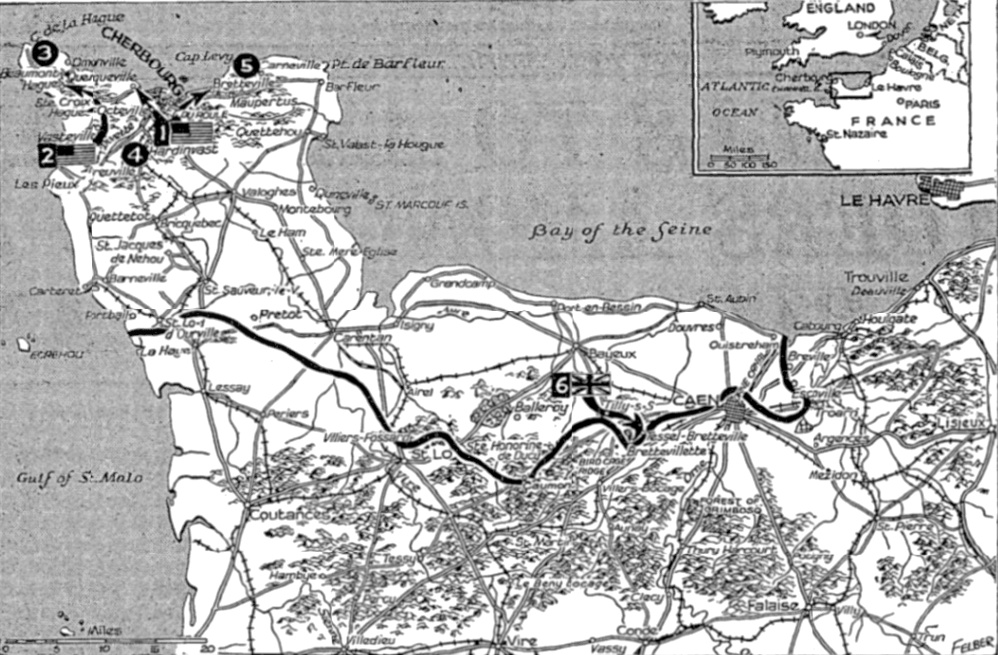LIFE (June 26, 1944)
Bayeux Tapestry reports old invasion
When the English-speaking allies fought their way into Bayeux June 7, they had returned to one of the great sources of English culture. That is the place from which Normans came in 1066 to conquer England. There, until the Germans came, hung the great Bayeux Tapestry which depicted the Battle of Hastings only a few years after it had been fought. Key examples of the 72 surviving scenes are reproduced here from the 230-foot embroidery on white linen, which used to be hung around the nave of Bayeux Cathedral. Today, three German scholars are studying it for Hitler in some “safe place,” said to be Linz, Austria. They have already described it as “a sort of German royal saga.”
By more respectable scholars, the Bayeux Tapestry has been called “the noblest monument in the world relating to English history” and “the most famous and most remarkable of medieval embroideries.” So factual is the work that the Bayeux Tapestry is one of our chief historical sources on the decisive Battle of Hastings. The borders are decorated with the Romanesque conceits then in fashion” griffins, phoenixes, fables, hunts, monsters, real animals.
The Battle of Hastings was the last great flare of infantry against armored cavalry for several centuries. The battle was won, however, not by mounted knights but by the Norman archers who pitched their arrows high and finally dropped one into Harold’s eye, killing him and demoralizing his army.
Harold, carrying a falcon (left), sets sail in Channel in 1064. Normans claim that he was going to pay a call on William of Normandy.
Landing in Normandy, Harold’s Saxons drop anchor in a calm sea. This contradicts Saxon story that Harold was shipwrecked in a storm. Saxons wear mustaches.
The seizure of Harold, by anchor, is effected by Count Guy. He surrendered him to Duke William, who released him after oath.
Harold sails home, having given oath to support William’s claim to throne of England on death of King Edward the Confessor.
Edward dies in 1066 and is hastily buried in St. Peter’s on site of Westminster Abbey. Harold is crowned King, violating his oath, a sacred thing in those times.
William’s fleet of about 700 open boats is built in the mouths of the Norman rivers. Each one carried about 20 men and three horses.
With a south wind setting out at midnight, Sept. 27, 1066, William’s fleet reaches Pevensey, England, by 9:00 a.m. The following four pictures are panorama of fleet.
Sailing swiftly by night, William carried “a great lantern” on mast of his own ship, the* Mora, as well as a brass Cupid on the prow.
The fleet carries not only Norman barons but also Breton and French adventurers to a total of perhaps 13,000 men, 2,000 horses.
A crusade was what Pope had called William’s expedition, for Harold had broken his word. Furthermore, William’s great-aunt was Edward the Confessor’s mother.
Landing at Pevensey on southeast coast of England is shown above. The horses are led ashore. Notice that Normans are clean-shaven.
In mail armor, Norman barons head for Hastings. Their weapons were the lance, sword, mace and kite-shaped shields. Duke William carried a mace in battle.
Normans dig entrenchments around camp at the town of Hastings and build a timber castle. They had won complete surprise.
The countryside is burned by Duke William’s men. His objective is to force Harold to fight quickly, before Normans supplies run out.
William (left) has his fine Spanish stallion, given him by King Alfonso of Spain, led up, to lead his army into battle. He has already caught two of Harold’s spies.
The Norman barons head for Hastings. Decorations at the top of the strip may include Harold’s personal insignia, The Fighting Man.
Harold’s spy, caught by the Normans, is shown the Norman host and in turn tells Duke William which way Harold is coming. William is left center, the spy at right.
The spy is released after having been wined, dined and impressed by Norman power, Decorations of strip include griffins, donkey.
Spy tells King Harold that the Normans are coming. Harold has formed strong shield wall on a ridge after marching 30 miles a day.
The battle begins with a volley of Norman arrows, then the charge by the heavily-armed Norman knights, here shown all across the bottom row of these two pages.
“Dex aie!,”cried Normans, meaning “God’s aid!” Replied Saxons, “Out! Out!” Another favorite Saxon cry: “Godemite” (God Almighty).
**The shield wall of housecarls of Harold is impregnable against charges of the Norman knights, and volley of javelins, casting axes and stones throws Normans back.
Norman allies were routed by Saxon levies, who pursued but were themselves cut to pieces on the open plain by the Norman knights.
The Norman horses, including William’s, are decimated by the Saxons.
At cry he is dead, William raises his helmet (left) and rallies his men.
In hand-to-hand fighting, King Harold’s two brothers are cut down.
Harold is killed (center), an unaimed arrow had pierced his eye.
The Norman knights harry the remnants of the Saxon shield wall.
